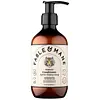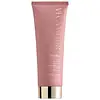What's inside
What's inside
 Key Ingredients
Key Ingredients

 Benefits
Benefits

 Concerns
Concerns

 Ingredients Side-by-side
Ingredients Side-by-side

Water
Skin ConditioningAloe Barbadensis Leaf Juice
Skin ConditioningCetearyl Alcohol
EmollientBehentrimonium Chloride
PreservativeCarthamus Tinctorius Oleosomes
EmollientParfum
MaskingBehentrimonium Methosulfate
Glycerin
HumectantQuaternium-87
CleansingPanthenol
Skin ConditioningSolanum Indicum Root Extract
Skin ConditioningSolanum Xanthocarpum Root Extract
MaskingStereospermum Suaveolens Root Extract
Skin ConditioningTribulus Terrestris Root Extract
Skin ConditioningPueraria Lobata Root Extract
HumectantAegle Marmelos Root Extract
Skin ConditioningDesmodium Gangeticum Root Extract
Skin ConditioningGmelina Arborea Root Extract
Skin ConditioningOroxylum Indicum Root Extract
Skin ConditioningPremna Serratifolia Root Extract
Skin ConditioningOrbignya Speciosa Kernel Oil
EmollientCocos Nucifera Oil
MaskingLinum Usitatissimum Seed Oil
PerfumingHibiscus Sabdariffa Flower Extract
Skin ConditioningTrigonella Foenum-Graecum Seed Extract
PerfumingBacopa Monnieri Extract
Skin ConditioningEclipta Prostrata Extract
Skin ConditioningWithania Somnifera Root Extract
Skin ConditioningCurcuma Longa Root Extract
MaskingEmblica Officinalis Fruit Extract
Skin ConditioningHelianthus Annuus Seed Oil
EmollientSesamum Indicum Seed Oil
EmollientTetrasodium Glutamate Diacetate
Melia Azadirachta Seed Oil
EmollientLactobacillus/Arundinaria Gigantea Ferment Filtrate
Skin ConditioningBrassica Campestris Seed Oil
Skin ConditioningOryza Sativa Bran Oil
EmollientAstrocaryum Murumuru Seed Butter
EmollientGluconolactone
Skin ConditioningGuar Hydroxypropyltrimonium Chloride
Skin ConditioningHydroxyethylcellulose
Emulsion StabilisingCetyl Alcohol
EmollientPhenoxyethanol
PreservativePotassium Sorbate
PreservativeEthylhexylglycerin
Skin ConditioningSodium Hydroxide
BufferingCitric Acid
BufferingIsopropyl Alcohol
SolventCoumarin
PerfumingWater, Aloe Barbadensis Leaf Juice, Cetearyl Alcohol, Behentrimonium Chloride, Carthamus Tinctorius Oleosomes, Parfum, Behentrimonium Methosulfate, Glycerin, Quaternium-87, Panthenol, Solanum Indicum Root Extract, Solanum Xanthocarpum Root Extract, Stereospermum Suaveolens Root Extract, Tribulus Terrestris Root Extract, Pueraria Lobata Root Extract, Aegle Marmelos Root Extract, Desmodium Gangeticum Root Extract, Gmelina Arborea Root Extract, Oroxylum Indicum Root Extract, Premna Serratifolia Root Extract, Orbignya Speciosa Kernel Oil, Cocos Nucifera Oil, Linum Usitatissimum Seed Oil, Hibiscus Sabdariffa Flower Extract, Trigonella Foenum-Graecum Seed Extract, Bacopa Monnieri Extract, Eclipta Prostrata Extract, Withania Somnifera Root Extract, Curcuma Longa Root Extract, Emblica Officinalis Fruit Extract, Helianthus Annuus Seed Oil, Sesamum Indicum Seed Oil, Tetrasodium Glutamate Diacetate, Melia Azadirachta Seed Oil, Lactobacillus/Arundinaria Gigantea Ferment Filtrate, Brassica Campestris Seed Oil, Oryza Sativa Bran Oil, Astrocaryum Murumuru Seed Butter, Gluconolactone, Guar Hydroxypropyltrimonium Chloride, Hydroxyethylcellulose, Cetyl Alcohol, Phenoxyethanol, Potassium Sorbate, Ethylhexylglycerin, Sodium Hydroxide, Citric Acid, Isopropyl Alcohol, Coumarin
Water
Skin ConditioningCetearyl Alcohol
EmollientMacadamia Integrifolia Seed Oil
Skin ConditioningAstrocaryum Murumuru Seed Butter
EmollientBehentrimonium Chloride
PreservativeCopaifera Officinalis Resin
MaskingParfum
MaskingAdansonia Digitata Seed Oil
EmollientBehentrimonium Methosulfate
Cetrimonium Chloride
AntimicrobialGlyceryl Behenate
EmollientSr-(Wasp Spider Polypeptide-1 Oligopeptide-178)
Skin ConditioningMoringa Oleifera Seed Oil
EmollientSclerocarya Birrea Seed Oil
HumectantCaprylyl Glycol
EmollientBrassicamidopropyl Dimethylamine
Skin ConditioningEthylhexylglycerin
Skin ConditioningHexylene Glycol
EmulsifyingPolyquaternium-10
Mannitol
HumectantPhosphatidylcholine
EmulsifyingXimenia Americana Seed Oil
EmollientTetrasodium Glutamate Diacetate
Aloe Barbadensis Leaf Juice
Skin ConditioningCetyl Alcohol
EmollientCeramide NP
Skin ConditioningCitric Acid
BufferingSodium Chloride
MaskingBiotin
AntiseborrhoeicBrassica Oleracea Italica Seed Oil
EmollientJasminum Grandiflorum Flower Extract
MaskingCananga Odorata Flower Oil
MaskingGardenia Jasminoides Fruit Extract
Cosmetic ColorantCitrus Junos Peel Oil
AstringentGlycerin
HumectantSodium Benzoate
MaskingPotassium Sorbate
PreservativePhenoxyethanol
PreservativeLimonene
PerfumingGeraniol
PerfumingCitral
PerfumingBenzyl Alcohol
PerfumingCitronellol
PerfumingAmyl Cinnamal
PerfumingFarnesol
PerfumingLinalool
PerfumingWater, Cetearyl Alcohol, Macadamia Integrifolia Seed Oil, Astrocaryum Murumuru Seed Butter, Behentrimonium Chloride, Copaifera Officinalis Resin, Parfum, Adansonia Digitata Seed Oil, Behentrimonium Methosulfate, Cetrimonium Chloride, Glyceryl Behenate, Sr-(Wasp Spider Polypeptide-1 Oligopeptide-178), Moringa Oleifera Seed Oil, Sclerocarya Birrea Seed Oil, Caprylyl Glycol, Brassicamidopropyl Dimethylamine, Ethylhexylglycerin, Hexylene Glycol, Polyquaternium-10, Mannitol, Phosphatidylcholine, Ximenia Americana Seed Oil, Tetrasodium Glutamate Diacetate, Aloe Barbadensis Leaf Juice, Cetyl Alcohol, Ceramide NP, Citric Acid, Sodium Chloride, Biotin, Brassica Oleracea Italica Seed Oil, Jasminum Grandiflorum Flower Extract, Cananga Odorata Flower Oil, Gardenia Jasminoides Fruit Extract, Citrus Junos Peel Oil, Glycerin, Sodium Benzoate, Potassium Sorbate, Phenoxyethanol, Limonene, Geraniol, Citral, Benzyl Alcohol, Citronellol, Amyl Cinnamal, Farnesol, Linalool
Ingredients Explained
These ingredients are found in both products.
Ingredients higher up in an ingredient list are typically present in a larger amount.
Aloe Barbadensis Leaf Juice comes from leaves of the aloe plant. Aloe Barbadensis Leaf Juice is best known for helping to soothe sunburns. It is also anti-inflammatory, moisturizing, antiseptic, and can help heal wounds.
Aloe is packed with good stuff including Vitamins A, C, and E. These vitamins are antioxidants, which help fight free-radicals and the damage they may cause. Free-radicals are molecules that may damage your skin cells, such as pollution.
Aloe Barbadensis Leaf Juice also contains sugars. These sugars come in the form of monosaccharides and polysaccharides, folic acid, and choline. These sugars are able to help bind moisture to skin.
It also contains minerals such as calcium, 12 anthraquinones, fatty acids, amino acids, and Vitamin B12.
Learn more about Aloe Barbadensis Leaf JuiceAstrocaryum Murumuru Seed Butter isn't fungal acne safe.
This ingredient is a preservative and often used for it's anti-static properties. You'll most likely see this ingredient in hair conditioners.
It does not cause irritation or sensitization in leave-on products at 1-5%.
Behentrimonium Methosulfate is an ammonium salt. It is mainly used to prevent static in haircare products as a surfactant.
Surfactants have differing ends: one side is hydrophilic while the other end is hydrophobic.
Surfactants also help your cleansers remove pollutants more easily from the skin.
Learn more about Behentrimonium MethosulfateCetearyl alcohol is a mixture of two fatty alcohols: cetyl alcohol and stearyl alcohol. It is mainly used as an emulsifier. Emulsifiers help prevent the separation of oils and products. Due to its composition, it can also be used to thicken a product or help create foam.
Cetearyl alcohol is an emollient. Emollients help soothe and hydrate the skin by trapping moisture.
Studies show Cetearyl alcohol is non-toxic and non-irritating. The FDA allows products labeled "alcohol-free" to have fatty alcohols.
This ingredient is usually derived from plant oils such as palm, vegetable, or coconut oils. There is debate on whether this ingredient will cause acne.
Due to the fatty acid base, this ingredient may not be Malassezia folliculitis safe.
Learn more about Cetearyl AlcoholCetyl Alcohol is a fatty alcohol. Fatty Alcohols are most often used as an emollient or to thicken a product.
Its main roles are:
Though it has "alcohol" in the name, it is not related to denatured alcohol or ethyl alcohol.
The FDA allows products labeled "alcohol-free" to have fatty alcohols.
Learn more about Cetyl AlcoholCitric Acid is an alpha hydroxy acid (AHA) naturally found in citrus fruits like oranges, lemons, and limes.
Like other AHAs, citric acid can exfoliate skin by breaking down the bonds that hold dead skin cells together. This helps reveal smoother and brighter skin underneath.
However, this exfoliating effect only happens at high concentrations (20%) which can be hard to find in cosmetic products.
Due to this, citric acid is usually included in small amounts as a pH adjuster. This helps keep products slightly more acidic and compatible with skin's natural pH.
In skincare formulas, citric acid can:
While it can provide some skin benefits, research shows lactic acid and glycolic acid are generally more effective and less irritating exfoliants.
Most citric acid used in skincare today is made by fermenting sugars (usually from molasses). This synthetic version is identical to the natural citrus form but easier to stabilize and use in formulations.
Read more about some other popular AHA's here:
Learn more about Citric AcidEthylhexylglycerin (we can't pronounce this either) is commonly used as a preservative and skin softener. It is derived from glyceryl.
You might see Ethylhexylglycerin often paired with other preservatives such as phenoxyethanol. Ethylhexylglycerin has been found to increase the effectiveness of these other preservatives.
Glycerin is already naturally found in your skin. It helps moisturize and protect your skin.
A study from 2016 found glycerin to be more effective as a humectant than AHAs and hyaluronic acid.
As a humectant, it helps the skin stay hydrated by pulling moisture to your skin. The low molecular weight of glycerin allows it to pull moisture into the deeper layers of your skin.
Hydrated skin improves your skin barrier; Your skin barrier helps protect against irritants and bacteria.
Glycerin has also been found to have antimicrobial and antiviral properties. Due to these properties, glycerin is often used in wound and burn treatments.
In cosmetics, glycerin is usually derived from plants such as soybean or palm. However, it can also be sourced from animals, such as tallow or animal fat.
This ingredient is organic, colorless, odorless, and non-toxic.
Glycerin is the name for this ingredient in American English. British English uses Glycerol/Glycerine.
Learn more about GlycerinParfum is a catch-all term for an ingredient or more that is used to give a scent to products.
Also called "fragrance", this ingredient can be a blend of hundreds of chemicals or plant oils. This means every product with "fragrance" or "parfum" in the ingredients list is a different mixture.
For instance, Habanolide is a proprietary trade name for a specific aroma chemical. When used as a fragrance ingredient in cosmetics, most aroma chemicals fall under the broad labeling category of “FRAGRANCE” or “PARFUM” according to EU and US regulations.
The term 'parfum' or 'fragrance' is not regulated in many countries. In many cases, it is up to the brand to define this term.
For instance, many brands choose to label themselves as "fragrance-free" because they are not using synthetic fragrances. However, their products may still contain ingredients such as essential oils that are considered a fragrance by INCI standards.
One example is Calendula flower extract. Calendula is an essential oil that still imparts a scent or 'fragrance'.
Depending on the blend, the ingredients in the mixture can cause allergies and sensitivities on the skin. Some ingredients that are known EU allergens include linalool and citronellol.
Parfum can also be used to mask or cover an unpleasant scent.
The bottom line is: not all fragrances/parfum/ingredients are created equally. If you are worried about fragrances, we recommend taking a closer look at an ingredient. And of course, we always recommend speaking with a professional.
Learn more about ParfumPhenoxyethanol is a preservative that has germicide, antimicrobial, and aromatic properties. Studies show that phenoxyethanol can prevent microbial growth. By itself, it has a scent that is similar to that of a rose.
It's often used in formulations along with Caprylyl Glycol to preserve the shelf life of products.
Potassium Sorbate is a preservative used to prevent yeast and mold in products. It is commonly found in both cosmetic and food products.
This ingredient comes from potassium salt derived from sorbic acid. Sorbic acid is a natural antibiotic and effective against fungus.
Both potassium sorbate and sorbic acid can be found in baked goods, cheeses, dried meats, dried fruit, ice cream, pickles, wine, yogurt, and more.
You'll often find this ingredient used with other preservatives.
Learn more about Potassium SorbateTetrasodium Glutamate Diacetate is a chelating agent. Chelating agents help prevent metal ions from binding to other ingredients. This helps prevent unwanted effects and reactions from a product. These metal ions may come from water and are found in miniscule amounts.
Tetrasodium Glutamate Diacetate can also help other preservatives be more effective.
Water. It's the most common cosmetic ingredient of all. You'll usually see it at the top of ingredient lists, meaning that it makes up the largest part of the product.
So why is it so popular? Water most often acts as a solvent - this means that it helps dissolve other ingredients into the formulation.
You'll also recognize water as that liquid we all need to stay alive. If you see this, drink a glass of water. Stay hydrated!
Learn more about Water